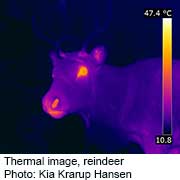
TUESDAY, Dec. 18 (HealthDay News) — Scientists report that they have uncovered the biology behind the magic of how Rudolph’s nose glows in the dark as he guides Santa’s sleigh around the globe on Christmas Eve.
It turns out that the trusty reindeer’s nose is neon red because it contains a large supply of tiny red blood cells, known as micro-vessels, that are essential for delivering oxygen and regulating temperature in the extreme cold.
Scientists in the Netherlands and Norway noted this enhanced “nasal microcirculation” of reindeer not only allows Rudolph to guide Santa’s sleigh, but also protects his nose and brain from freezing temperatures.
“The microcirculation of the nasal mucosa in reindeer is richly vascularized, and 25 percent denser than that in humans,” the study authors wrote. “These factors explain why the nose of Rudolph, the lead flying reindeer employed by Santa Claus to pull his sleigh, is red and well-adapted to carrying out his duties in extreme temperatures.”
The researchers used hand-held video microscopes to examine the noses of five healthy people and two reindeer. They found the reindeer had a circulating blood vessel density that was 25 percent higher than the people. This provided the reindeer with a very rich concentration of red blood cells. Infrared thermal images also revealed it made their noses red.
The reindeer noses also had a high density of mucous glands, which protected them from extreme temperatures and changing weather conditions. The researchers noted the mucous glands also served as a protective barrier and a means of fluid transport.
The study was published online Dec. 17 in the BMJ Christmas issue.
More information
The U.S. Centers for Disease Control and Prevention provides tips on how to stay safe and warm in winter.

